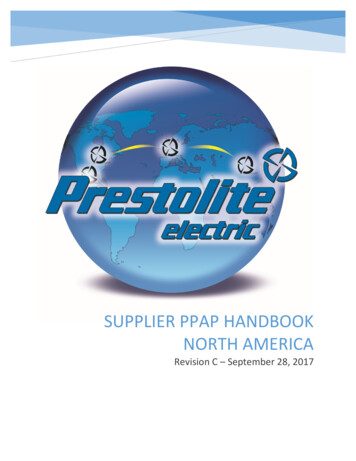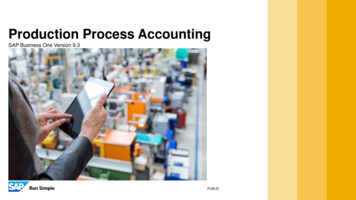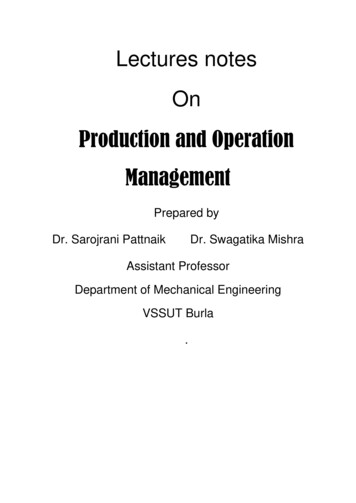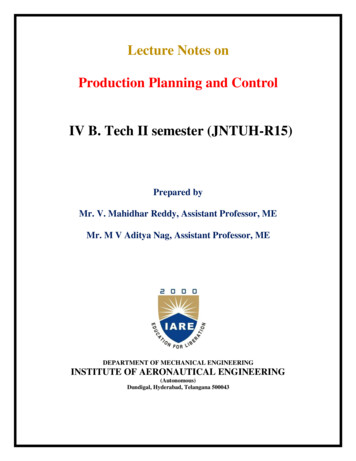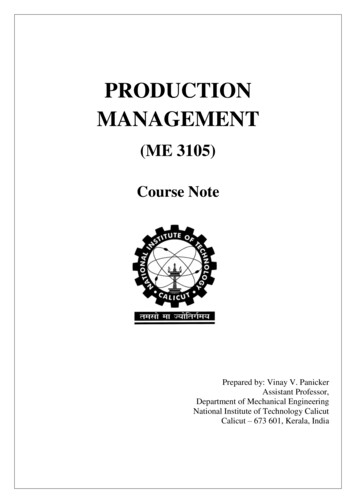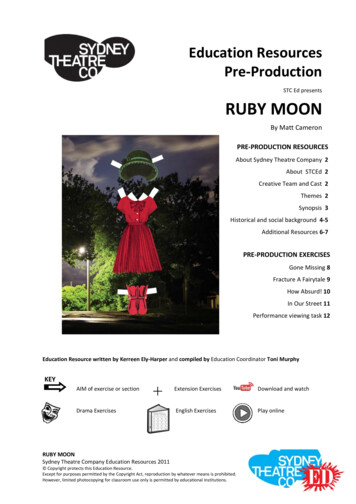
Transcription
Education ResourcesPre‐ProductionSTC Ed presentsRUBY MOONBy Matt CameronPRE‐PRODUCTION RESOURCESAbout Sydney Theatre Company 2About STCEd 2Creative Team and Cast 2Themes 2Synopsis 3Historical and social background 4‐5Additional Resources 6‐7PRE‐PRODUCTION EXERCISESGone Missing 8Fracture A Fairytale 9How Absurd! 10In Our Street 11Performance viewing task 12Education Resource written by Kerreen Ely‐Harper and compiled by Education Coordinator Toni MurphyKEYAIM of exercise or section Drama ExercisesExtension ExercisesDownload and watchEnglish ExercisesPlay onlineRUBY MOONSydney Theatre Company Education Resources 2011 Copyright protects this Education Resource.Except for purposes permitted by the Copyright Act, reproduction by whatever means is prohibited.However, limited photocopying for classroom use only is permitted by educational institutions.
PRE‐PRODUCTION RESOURCESABOUT SYDNEY THEATRE COMPANYwww.sydneytheatre.com.au/aboutABOUT STCEDwww.sydneytheatre.com.au/stced/aboutCREATIVE TEAMDirector – Sarah GilesSet & Costume Designer – Pip RuncimanLighting Designer – Matt CoxComposer and Sound Designer – Kingsley Reeve“SYLVIEWas there a child Ray?CASTEpilogueSylvie – Eliza LoganRuby MoonRay – Jo TurnerVoice of Ruby – Rose Richards”THEMESAbsurdismFairytalesLost Child NarrativeSuburbiaBelongingRUBY MOON2Sydney Theatre Company Pre‐Production Education Resources 2011www.sydneytheatre.com.au/stced Sydney Theatre Company
SYNOPSISRuby Moon dressed in a red dress goes to visit her granny at the end of the street and neverreturns. Every child’s fear and every parent’s nightmare comes to life in this dark absurdist taleof Australian suburbia.Sylvie and Ray Moon, a couple from the town of Flaming Tree Grove, are struggling to come toterms with the disappearance of their six year old daughter, Ruby. Hoping to trigger someone’smemory of having seen Ruby they keep a child mannequin who is dressed in the same clothesRuby was last seen in. They are ready to give up hope, until the arm of Ruby's doll turns up intheir letterbox. They retrace the events that lead up to her disappearance and set about toconduct their own investigation by interviewing all the neighbors in the street. Their weird andeccentric neighbours include a born again Christian, an ex‐soldier, Ruby’s former babysitter anda mad scientist. All hint of knowing what happened to Ruby. The strangest and most elusivecharacter is referred to as 'The Wizard'‐ a former runaway who returned home to find hisparents had moved away. He is never seen, but often knocks on the Moons' door.Haunted by their missing child Ray and Sylvie descend further into a nightmarish world wherethe boundaries between the real and imaginary become increasingly blurred. When Sylviereenacts her daughters return as Ruby we are left wondering if they will ever get over notknowing what happened to their missing child.The story continues What happened to Ruby? Where is she? Will she ever be found? Did she ever exist?RUBY MOON4Sydney Theatre Company Pre‐Production Education Resources 2011www.sydneytheatre.com.au/stced Sydney Theatre Company
HISTORICAL AND SOCIAL BACKGROUND OF THE PLAYRuby Moon combines the elements of absurdism, gothic horror, and fairy tales with theparanoia of suburban myths as well as drawing upon from real‐life headlines about missingchildren.Matt Cameron describes his work as absurdist. Absurdism has its origins in the EuropeanSurrealist movement of the 1920’s. Playwrights Alfred Jarry and Eugene Ionesco wereexponents of the philosophy of Absurdism. The devastation of the first world war left manypeople with a profound sense of dissatisfaction with the old world values and beliefs. TheAbsurdist theatre was fiercely anti‐realist and anti‐scientific. Devoid of moral decency humanswere shown to be as monstrous and irrational as the world they lived in. The European fairytaleof industrialization bringing progress and enlightenment had come to an end and theAbsurdist’s were looking for new ways to understand and represent human behaviour.Fairy tales are often associated with moral lessons, daydreams and wish‐fulfilment fantasies ofbeing rescued, becoming wealthy, finding true love or our way back home. They are oftenstructured as quest narratives where the main character meets both helpers and mentors ontheir journey that always closes with a happy ending.Fairytales have their origins in religious stories, cultural myths and legends that have beenpassed down by generations of storytelling most often from adults to children. Europeanfairytales such as the Grimm Bothers or Hans Christian Anderson collections were reflections ofthe cultural values and historic times they were written in. Many of the original stories wereviolent and intended to frighten children into ‘good behaviour’ by dramatizing theconsequences of ‘bad behaviour’. Walt Disney Studios revised many of these traditionalfairytales to make them more acceptable to middle‐class audiences from the 1930’s (See 1937version of Snow‐white and the Seven Dwarfs, Cinderella 1950, Sleeping Beauty 1959). This shiftoccurred with the advancement of child psychology and developmental studies in child learningthat challenged harsh discipline practices. Critiques of the hidden meanings within fairytalesbegan in earnest in psychoanalytic and literature studies from the late 1950’s and peaked withRUBY MOON5Sydney Theatre Company Pre‐Production Education Resources 2011www.sydneytheatre.com.au/stced Sydney Theatre Company
feminism in the 1970‐1980’s resulting in numerous adaptations particularly into the popular‘fractured’ fairytale as a form of satire and social commentary on the representation ofpatriarchal family structures, femininity and power.Matt Cameron chooses not to give his audience a fairytale happy ending with Ruby returninghome. While drawing inspiration from real‐life missing children cases he has been careful notto have his play read as based on any one story . Ruby Moon is concerned for the symbolic ‘lostchild’ that represents not just one particular child but all children (including adults who werechildren once themselves).The Australian psyche has a long held fascination with the stories of lost children. The ‘lostchild’ narrative is imbued with a sense of loss generated by the possibility of returning home.Typically, the Australian ‘lost child’ narrative involves an innocent child wandering into thebush, who becomes disoriented and frightened, and learns a lesson about the limits to theirbush survival skills. However, some never return leaving us to contemplate the worst and themystical.ConsiderThe main action of Ruby Moon is from the parent’s point of view.Fairytales reflect a society’s attitude toward children.Traditional fairytales end in happiness.Beneath absurdist drama’s grotesque comedy there is a deep concern for the human condition.Ruby is present through her absence.RUBY MOON6Sydney Theatre Company Pre‐Production Education Resources 2011www.sydneytheatre.com.au/stced Sydney Theatre Company
Additional ResourcesThe WriterInterview with Matt Cameron ‘What I Wrote’ series DVD Ronin FilmsTrailer gives brief excerpts of definition of Absurdism and his approach to ost Child Narratives in Australian Literature‐‐‐‐‐‐Billabong series Mary Grant BrucePicnic At Hanging Rock Joan Lindsay (Peter Weir film)Rabbit Proof Fence Doris Pilkington (Phillip Noyce film)Walkabout James Marshall (Nicolas Roeg film)Tomorrow Series John MarsdenDot and the Kangaroo Ethel C PedleyA natural(ised) home for the Lintons: Lost children and indigenising discourse in Mary GrantBruce’s and John Marsden’s young adult fiction 2009Elspeth Tilley, Massey University, Wellington, New �Missing Children’ FilmsThe Golden Child 1986A Cry in The Dark 1988 (dramatization of Azaria Chamberlain case)The City of Lost Children 1995Gone Baby Gone 2007Changeling2008Fairytale CritiquesA.S Byatt Introduction to The Annonated Brothers GrimmCatherine Orenstein Little Red Riding Hood Uncloaked 2002Red Riding Hood AdaptationsBooksThe Little Girl and the Woolf James ThurberLittle Red Riding Hood and the Wolf Roald DahlThe Book of Fairytales Angela CarterRUBY MOON7Sydney Theatre Company Pre‐Production Education Resources 2011www.sydneytheatre.com.au/stced Sydney Theatre Company
FilmsIn the Company of Wolves directed by Neil JordanFreeway directed by Matthew BrightAbsurdism & related movements ‐ Surrealism & DadaismPlays of Alfred Jarry – Ubu Roi seriesPlays of Eugene Ionesco – Rhinoceros, The Chairs, The Lesson, The Bald Prima DonnaPaintings by Salvador Dali, Jean MiroSculpture by Marcel DuchampPhotographs by Man Ray, Dorothea TanningWritings of Andre Breton, Albert Camus, Franz KafkaFilm by Luis BunelGothic/Fairytale HybridsFilms of Tim Burton – Corpse Bride, Edward Scissorhands, Beetlejuice, Sleepy HollowShrek seriesPrincess and the Frog directed by Ron Clements 2009 – social‐political re‐casting of traditionallywhite princess as African –American (aligned with Obama Presidency)Tangled 2011 Walt Disney re‐working of Rapunzel fairytaleRUBY MOON8Sydney Theatre Company Pre‐Production Education Resources 2011www.sydneytheatre.com.au/stced Sydney Theatre Company
GONE MISSINGAIM: To introduce the play’s theme of belonging and to increase level of empathy andunderstanding of the characters experience of loss.Have you ever had something or some‐one precious to you go missing ‐ a favourite toy, abeloved family pet, a special piece of jewellery?Have you ever had a good friend or family member who you’ve lost touch with?How old were you?What happened?How did you feel at the time?Did you ever find your missing item/person?If so, how were you reunited? If not, how do you feel about the loss now? Have your feelingschanged?“Devise & present a short scene based on yourpersonal story of loss.RUBYConsiderIt begins like a fairytale .Where?PrologueWhen?Ruby MoonWhat?”Who?Why? Extension‐ Alternative EndingsIf your scene ends happily with the character being reunited with their missing person/objectrepeat the scene with an alternative ‘unhappy’ ending. And visa versa.Discuss the different outcomes.What did you notice about how people deal (or don’t) with loss in their lives?RUBY MOON9Sydney Theatre Company Pre‐Production Education Resources 2011www.sydneytheatre.com.au/stced Sydney Theatre Company
FRACTURE A FAIRY TALEAIM: To indentify and understand the function of the fairytale narrative embedded within theplay.Research FairytalesDo you have a favourite fairytale?If so, what is it and why?If not, do you have a favourite story you liked to be told as a small child?What was the story and what did you like aboutthe story?“DiscussDULCIEWhy do we tell children fairytales?With the little girl and theWho tells children fairytales?wolf? Does it end well?What is the purpose of fairytales?Scene 1List the typical features of a fairytale.Ruby Moon”Ruby Moon references the Brothers Grimm’sLittle Red Riding Hood fairytale.Research the different versions of Little Red Riding Hood.Compare and contrast the versions.What is the purpose of the story?Devise & Present a version of Little Red Riding Hood with a complication.Consider changing theSetting – urban, rural, marineTime – past, present, futureStyle – western, sci‐fi, musical, soap opera etcCharacters – incorporate characters from other fairytales (as in the films Shrek, Tangled )RUBY MOON10Sydney Theatre Company Pre‐Production Education Resources 2011www.sydneytheatre.com.au/stced Sydney Theatre Company
HOW ABSURD!AIM: To identify and explore the application of absurdist elements in a dramatic text.Research AbsurdismMake a list of typical elements in an Absurdist playWhat it is not!Walk around the room.Name everything you see ‘what it is not’ – a desk is a bed, a door a waterfall, a pen is a phoneand so on.Devise & Present an absurdist scene where something changes into something it is not.For example in Ruby Moon the mannequin forSophie becomes a substitute for the real Ruby.“ConsiderDULCIEExaggerated characters and situationAre you sure she wasGrotesque c – where something becomes whatScene 1Ruby MoonRUBY MOON”it is not in reality (a man becomes a rhinoceros asin Eugene Ionesco’s play Rhinocerous )11Sydney Theatre Company Pre‐Production Education Resources 2011www.sydneytheatre.com.au/stced Sydney Theatre Company
IN OUR STREETAIM: To develop and apply skills in devising and performing absurdist drama on theme ofsuburbia and belonging.Story Word InterruptionIn pairs.A begins a story.B interrupts the story with random word/s (one at a time)A must incorporate the word/s into the storyRepeat and reverse roles.How did the stories change with each word interruption?Write a list of noun words on separate pieces of paper ‐ objects, places, things, person, quality,action (be bold and surprising in your ideas)Put in a container & mix them up.Choose 5 random words (without looking!)Devise & Present a scene entitled ‘In Our Street ’ incorporating the 5 words.Don’t forget your Absurdist checklist – grotesque, anti‐realistic, exaggerated! Extension: Repeat prepared scene with audience/facilitator introducing elements from RubyMoon that must be immediately incorporated into the scene.For example: a knock at the door, sudden darkness, a full moon, a doll’s arm Discuss the scenesHow did they change – mood, character behaviour, narrative logic?How did the audience react?RUBY MOON12Sydney Theatre Company Pre‐Production Education Resources 2011www.sydneytheatre.com.au/stced Sydney Theatre Company
Performance Viewing Task – While watching Ruby Moon:Look & Identify the absurdist elements in the productionConsiderStage DesignCostume DesignMusic & Sound DesignActing StyleMood & Tone of the performanceAudience’s responsesHow did you feel during the performance – did your mood change?When and why?“RAYWe told her to never trust astranger EpilogueRuby MoonRUBY MOON13Sydney Theatre Company Pre‐Production Education Resources 2011www.sydneytheatre.com.au/stced Sydney Theatre Company”
Memories, Mourning & SecretsAIM: To explore the theme of memories, mourning and secrets in Ruby MoonMemory StoriesTelling stories is a way of remembering people andevents. Sylvie and Ray keep the memory of Ruby alive by“telling stories.SYLVIEShe loves her stories, Ray.She’ll never be too old forWhy is it important for Sylvie and Ray to not forget Ruby?What are other ways that Sylvie and Ray rememberthem.PrologueRuby MoonRuby?Why are there no photos/images of Ruby? ”ExtensionResearch a real life case study of a missing child, such as Madeleine McCann who went missingin 2007.What happened?Was the child ever found?How did the parent/s respond? Relatives and friends, general public, and the media?Share your research findings with the class.Mourning & Loss: The Nine Stages of GrievingIn 1969, Dr Elizabeth Kübler‐Ross developed a five stage grief cycle which outlined the specificways in which people deal with loss and trauma. Since then, the cycle has been expanded toinclude nine ‐Anger‐Testing‐Physical Distress‐Acceptance‐GuiltRUBY MOONSydney Theatre Company Education Resources 2011 Copyright protects this Education Resource.Except for purposes permitted by the Copyright Act, reproduction by whatever means is prohibited.However, limited photocopying for classroom use only is permitted by educational institutions.
Research the *Nine Stages of Grieving (or Seven Stages of Grieving if preferred).Divide into groups, allocating a different stage to each group.Compare the Nine Stages of Grieving with the behaviour and actions of Sylvie and Ray andother characters from the play.Support your ideas with specific references from the play (including quotes).*NB: Remember the stages function as a guide only to help us understand how peopleexperience loss and trauma.Truth, Lies and SecretsExplore the question ‘Where is Ruby?’ConsiderRuby was abducted by aliens.Ruby was taken by the Wizard.Ruby is behind the curtain.Ruby’s disappearance was staged by her parents.Ruby never existed.Defend your theory of what has happened to Ruby with evidence from the play.For example, could Ruby have disappeared into Professor Carl Ogle’s ‘Portable Black Hole’?CARL: Strictly I didn’t do anything. But I take full responsibility for my invention. Mytheory is I must have left the lab door unlocked, allowing Penelope to creep in.She was always hungry for mice. She’d already eaten three. Ruby must havefollowed her in and stumbled upon my first prototype. Much larger diameter.Very powerful. Would have taken them both in an instant.Performance ReflectionWhat do you know about Sylvie and Ray by the end of the performance?How does the ending reflect the director’s vision of the play?RUBY MOON2Sydney Theatre Company Post‐Production Education Resources 2011www.sydneytheatre.com.au/stced Sydney Theatre Company
VoicesAIM: To examine the use of imagery, language, and narrative voice in Ruby MoonRAY: I could read you the story, baby?SYLVIE: Yes, tell me the story, Ray. I want to hear the story.With the voices. Do the different voices.Image & Narrative VoiceWhy does Sylvie ask Ray to read her the story in “different voices”?When reading a dramatic story aloud to an audience how can you bring the text to life?How do adults often read stories to children? And why?Read Aloud & Discuss the selected text:RAY:[reading] ‘It had been one of those scorching summer daysWhen all the world appears ablazeSprinklers swivelled to a hypnotic beatCicadas pulsed to the shimmering heatConcrete was caramel under your feet andThe ice‐cream van turned slow motion into the dead‐end street.The setting sun lit the flame trees one by oneHer mother looked down the grove like the barrel of a gunAs the little girl turned like a page to wave farewellBefore skipping away down the path to hell.’He snaps the book shut.ConsiderKey ImageryWord usage – Alliteration ‘scorching summer’Assonance ‘slow motion’Rhyme ‘days’ , ‘ablaze’Metaphor – the summer heat is like .?RUBY MOONSydney Theatre Company Education Resources 2011 Copyright protects this Education Resource.Except for purposes permitted by the Copyright Act, reproduction by whatever means is prohibited.However, limited photocopying for classroom use only is permitted by educational institutions.
Interpretation – of an Australian suburban street in summerNarrative Structure – how does the story begin, develop and end?Brainstorm ideas for the ‘different voices’ – how they might change and develop?For example, the first voice might begin softly and be spoken in a reassuring tone.Take a line eachSpeak each line with a different voice to convey a different intention, a different mood tocreate a different dramatic effect. ExtensionCreate a moving body sculpture that becomes the story.Speak the text with accompanying movement. ExtensionCompare & Contrast Ray’s story text with the following character dialogue.SYLVIE: Don’t stop. Keep going.RAY: I can’t do the story tonight.SYLVIE: You have to.RAY: I can’t bear it.He gets up and slams the book downSYLVIE: I want to know how it ends.RAY: It doesn’t end well.SYLVIE: I don’t want to hear that story.RAY: Grow up, Sylvie! Grow up!He releases her. Silence.ConsiderLength of sentencesEmotional toneRhythmCharacter motivationRUBY MOON2Sydney Theatre Company Post‐Production Education Resources 2011www.sydneytheatre.com.au/stced Sydney Theatre Company
Perform the scene from Ray’s story telling through to include the above dialogue.Discuss the shifts in narrative voice with reference to structure, tone and dramatic effect.Music As TextRUBY: [singing, voice‐over] ‘She’s not in the roomHide from the world“RUBYThe curtain girl She’s not in the roomBehind the curtain girl,’She’s not outsidePrologue & EpilogueRuby MoonDiscuss the use of music and song in the production.”Why does Ruby communicate only through song?The music of the sixteenth century song ‘Greensleeves’ (written by Henry VIII) features in theproduction:Alas, my love, you do me wrong,To cast me off discourteously.For I have loved you well and long,Delighting in your company.Chorus: Greensleeves was all my joyGreensleeves was my delight,Greensleeves was my heart of gold,And who but my lady greensleeves.Discuss the significance of the ice‐cream van’s music–box playing ‘Greensleeves’.RUBY MOONSydney Theatre Company Education Resources 2011 Copyright protects this Education Resource.Except for purposes permitted by the Copyright Act, reproduction by whatever means is prohibited.However, limited photocopying for classroom use only is permitted by educational institutions.
Creative Missing Persons ReportWrite/Perform Sylvie and Ray giving a ‘Missing Persons Report’ to Detective Holloway.Your missing person’s report for Ruby Moon will need to provide the following informationwith specific references (including quotes) from the play text:‐ physical description of Ruby including distinguishable features‐ a recent photograph (or drawing ) of Ruby‐ where and when Ruby was last seen or heard from‐ places Ruby may visit‐ list of any medical problems or medications Ruby may need‐ names and contacts of friends associated with Ruby.Reference: Australian Federal Police help/ ExtensionDesign a ‘Missing Person’ advertisment for Ruby.Research ‘Missing Children’ websites.Design a web site to assist in finding Ruby.RUBY MOON4Sydney Theatre Company Post‐Production Education Resources 2011www.sydneytheatre.com.au/stced Sydney Theatre Company
Warning TalesAIM: To examine the cultural practices and social issues represented in Ruby MoonMy parents are always warning me List warnings parents give to their children.Discuss the responsibilities of being a parent.Debate ‘What makes a good parent?’“RAYWhat if she’s still alive ?ConsiderDifferent Cultural Practices, Values & BeliefsScene 7Ruby MoonLegal ResponsibilitiesSocial Expectations”Generational DifferencesSYLVIE: I want to know how it ends.RAY: It doesn’t end well.SYLVIE: I don’t want to hear that story.RAY: Grow up, Sylvie! Grow up!What kind of parents are the Moons?Why does Ray call Sylvie “baby”?Why does he tell Sylvie to “grow up”?Who is the real child in Ruby Moon?Write/Perform a scene based on your research and discussion of parent warnings to children.Consider titles‘Never speak to strangers’‘Be careful not to stray from the path’‘What I put on Facebook’‘Not doing my homework’Ten Years Later .RUBY MOONSydney Theatre Company Education Resources 2011 Copyright protects this Education Resource.Except for purposes permitted by the Copyright Act, reproduction by whatever means is prohibited.However, limited photocopying for classroom use only is permitted by educational institutions.
Write/Perform two alternative endings.‘Ten years later Ruby returns home .’‘Ten years later and Ruby has still not returned ’Performance ReflectionWhat does the director want the audience to be feeling and thinking about at the end of theperformance?List three things you think are important about this play for adults and young people.AbsurdismThe playwright, Matt Cameron never reveals where Ruby is but instead offers up varyingperspectives on what may have happened to her, who might be responsible and where shemight be.How is this approach consistent with Absurdism’s emphasis on anti‐realism, the grotesque anddeep concern for the human condition?Adaptation‘Ruby Moon takes the typical Australian lost child narrative, replacing the bush with thesuburban street.’‘It’s that ability to prosper as a cautionary story and benign children’s tale, as the basis for aliterary work or an improvised bedtime yarn, which makes the fairytale so enduring. More thananything, they’re flexible.’Craig MathiesonThe Sydney Morning Herald, 27th March 2011Discuss these statements with reference to Matt Cameron’s adaptation of the fairytale to acontemporary Australian setting.RUBY MOON2Sydney Theatre Company Post‐Production Education Resources 2011www.sydneytheatre.com.au/stced Sydney Theatre Company
UnexpectedAIM: To increase understanding and appreciation of Ruby Moon’s design concept anddirectorial approach.‘The theatre space I designed is really very plain and bland when you look at it . it’s just aroom with curtains!’‐ Pip RuncimanSpace TransformationIn Ruby Moon the space essentially stays the same throughout the performance and there areno scene changes. Everything happens in one space. Within this space lie deep‐seatedmemories and secrets and worlds within worldswithin worlds.Discuss how designer, Pip Runciman, transforms theordinary and real world into the strange andunexpected?Consider“CARLShe loved cartoonsScene 10Ruby MoonUse of LightSound & MusicObjects & Furniture”Does the design reference a specific time period? If yes, which period/s? If no, why not?Character & Costume TransformationThe characters in Ruby Moon are all archetypes.Archetype (Greek for ‘ original pattern’ ) is a basic model from which copies are made. In dramaarchetype characters represent the most typical and essential characteristics of humanbehaviour. They are characters who demonstrate universal personality types and roles. Forexample: the rebel, the hero/heroine, the mother, the witch, the villain, the traitor, the snob,the beggar, the trickster.RUBY MOONSydney Theatre Company Education Resources 2011 Copyright protects this Education Resource.Except for purposes permitted by the Copyright Act, reproduction by whatever means is prohibited.However, limited photocopying for classroom use only is permitted by educational institutions.
Research the archetypes that commonly appear in fairytales – if the wolf is the villain archetypein Red Riding Hood, who does the grandmother represent?List three things about each character in Ruby Moon that makes them an archetype.Ruby Moon’s costume design is believable and everyday with simple changes.The actors play multiple roles throughout the performance.Performance ReflectionHow do the actors transform from one character to another?ConsiderCostumePostureFacial ExpressionArchetype CharacteristicsPhysical GestureVoiceMovementHow does the costume design support the actors having to play multiple characters?How do the design choices impact on the directorial approach and acting style of theperformers?Object TransformationIn Ruby Moon the unexpected is explored in the use of everyday objects.Select an every day object that has the potential to represent many things. For example a chair,a pencil, a book.Pass the object round the circle.Transform the object into something unexpected. ExtensionDevise/Present a scene when an object must changes three times ‐ a book becomes a hat, apen a gun, a chair a space ship Performance ReflectionHow many everyday objects were used in unexpected ways during the performance?How effective was object transformation as a theatrical device?RUBY MOON2Sydney Theatre Company Post‐Production Education Resources 2011www.sydneytheatre.com.au/stced Sydney Theatre Company
Everyday Suburbia Becomes A NightmarePip Runciman was inspired by Tim Burton’s film Beetlejuice for its depiction of the ordinaryurban environment contrasted against the strange world of the characters hidden within thehouse.In designing Ruby Moon she has aimed to capture the ‘otherworldliness’ within theordinariness of Australian suburbia. Where we recognize things we might find in our own worldas normal at first glance but then are noticed to be not quite right when we look again.Describe a typical Australian street.Consider key features of your own street, what makes it typically Australian, what makes itunique?Make an Image Board (Poster or Drawing) of the ‘Everyday Suburban’ street – include photos,drawings, objects.Re‐Make the Image Board transforming the ‘Everyday Suburban’ street into the ‘Nightmare’street.Drawing on the contrast between urban everyday ‘boring’ and the strange bizarreChange the images by adding, subtracting, exaggerating elements, make them strange, creepy,otherworldly, weird.Remember your Absurdist checklist – anti‐realistic, anti‐scientific, grotesque, exaggerated.Performance ReflectionHow do the designer and director achieve a claustrophobic and otherworldly mood?Describe three moments in the performance when shifts occur from ordinary suburbia to theunexpected and strange.Compare & Contrast the vision and design concept of this production with the vision anddesign concept of the STC’s 2008 production of Ruby Moon directed by Andrew Upton ‐ a linkto a video of Andrew and the designer, Jo Briscoe discussing their tion/performance.asp?pid 212&typeid 4&secid 101RUBY MOON2Sydney Theatre Company Post‐Production Education Resources 2011www.sydneytheatre.com.au/stced Sydney Theatre Company
Ruby Moon dressed in a red dress goes to visit her granny at the end of the street and never returns. Every child’s fear and every parent’s nightmare comes to life in this dark absurdist tale .



